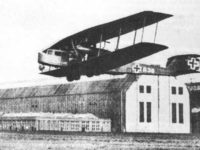The Zeppelin (Staaken) R.VI was the most successful long-range bomber of the company Zeppelin, which was built and used during the First World War. Together with the Gotha G.IV bombers London was bombed with this plane.
Development and construction:
At the end of 1914, the German army commanders demanded a heavy bomber from the German aircraft manufacturers to replace the no longer up-to-date zeppelins for strategic bombardments.
In addition to other companies, the company Zeppelin began with the development of such an aircraft. The first two prototypes called VGO.I and VGO.II were three powered biplanes. The next three prototypes VGO.III, VGO.IV and VGO.V had six engines.
Only with the VGO.VI, which was renamed later in Zeppelin (Staaken) R.VI, the otherwise usual four engines were used. At the driver's cab for the first time glass was installed to make it easier to fly in bad weather. A total of 18 aircraft of this type were built and delivered to the front.
Of the successor models is only known that the prototype of the Zeppelin (Staaken) R.VII crashed in a test flight. Other variants were still of the Zeppelin (Staaken) R.XIV, the Zeppelin (Staaken) R.XV and the Zeppelin (Staaken) R.XVI, which were built with five or last with four engines.
Use in the First World War:
The Zeppelin (Staaken) R.VI aircraft were used from mid-September 1917 along with the Gotha IV bombers to fly from Belgium from air raids on London.
Although the damage to buildings and the infrastructure remained low, the psychological impact was much greater. Especially since the beginning of 1918, the British had no aircraft that could fly so high to attack the bombers, only with the development of better anti-aircraft guns could these be fought.
Of the 18 aircraft delivered to the front, six were still in use at the end of the war. Under the terms of the Treaty of Versailles, Germany had to either extradite or destroy all its bombers.
Technical specifications:
| Designation: | Zeppelin (Staaken) R.VI |
| Country: | German Empire |
| Typ: | Bomber |
| Length: | 22,1 meters |
| Span: | 42,2 meters |
| Height: | 6,3 meters |
| Mass: | unknown |
| Crew: | Max. 7 |
| Engine: | four liquid-cooled Mercedes-D IVa six-cylinder in-line engines with each 260 hp |
| Maximum speed: | 135 km/h |
| Reach: | 800 kilometers |
| Armament: | 4 - 7 x 7,92 mm Parabellum LMG 08/15 machine guns and up to 2000 kg bombs |
You can find the right literature here:
Fokker Dr I Aces of World War 1 (Aircraft of the Aces)
Undoubtedly the most famous fighter type to see service on either side during World War 1, the Fokker Dr I was a revelation when it entered service on the western front in 1917. Manfred von Richthofens JG 1 circus was the first Jasta to completely re-equip with the new fighter, and in the skilled hands of its numerous aces the Dr I proved a formidable opponent. The Dr I remained in service on the Western Front until replaced by the superior Fokker D VII in May 1918. Just weeks prior to that, however, Germanys leading ace, the great Red Baron, had been killed at the controls of a Dr I.
Friedrichshafen Aircraft of WWI: A Centennial Perspective on Great War Airplanes (Great War Aviation) (Volume 21)

Friedrichshafen Aircraft of WWI: A Centennial Perspective on Great War Airplanes (Great War Aviation) (Volume 21) Paperback – February 16, 2016
This book describes and illustrates the development of Friedrichshafen aircraft of WWI with text, 540 photos, 18 in color, 37 color profiles, production quantities and serial numbers of aircraft, and aircraft dimensions and performance specifications. In addition, there are 26 official SVK drawings and 11 aircraft are illustrated in scale drawings to 1/48 (4) or 1/72 (7) scales. The book has 312 pages and is of interest to aviation historians, enthusiasts, and modelers alike.
German and Austro-Hungarian Aircraft Manufacturers 1908-1918
Much has been written about the British aircraft of the First World War, but little has surfaced about the aircraft of the Axis powers, Germany and Austria. Here, Terry C. Treadwell tells the story of the aircraft from companies such as Fokker, builder of the famous triplane, as fl own by Baron von Richthofen's Flying Circus, AEG, Albatros, Junkers and Hansa. From reconnaissance aircraft to state-of-the-art bombers that could reach London, this is the definitive guide to aircraft of the Axis powers during the First World War. The aircraft are explained in detail and a history of each company is provided, making this an excellent source book for aircraft enthusiasts, model makers and those interested in the air war over the trenches of France and Belgium, as well as further afield in the Italian campaign.
The Zeppelin in Combat: A History of the German Naval Airship Division
The standard reference now revised and expanded. Dr. Robinson has opened up his vast photo archives to enhance this new edition of his classic work. Much of the new photographic material is published here for the first time.
This post is also available in:
 Deutsch (German)
Deutsch (German)  Français (French)
Français (French)  Italiano (Italian)
Italiano (Italian)  简体中文 (Chinese (Simplified))
简体中文 (Chinese (Simplified))  Русский (Russian)
Русский (Russian)  Español (Spanish)
Español (Spanish)  العربية (Arabic)
العربية (Arabic)
















